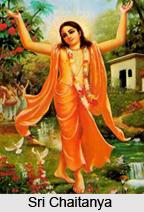 Nabadwip is a city in West Bengal in the Nadia district. The meaning of Nabadwip is "9 islands", it is a Bengali term. The nine islands are Antardwip, simantadwip, Madhyadwip, Rudradwip, Ritudwip, Godrumdwip, Jahnudwip, Modadrumdwip and Koladwip. Known as Nabadwip Dham, the place pulls in a huge crowd everyday, not only in India but also from all over the world. An integral part of the Lord Krishna consciousness, engulfed this beautiful serene place of Nabadwip, where we can also see devotee like Chaitanya Mahaprabhu. It is the land of Gaudiya Vaishnavism and the visiting place for pilgrims worldwide who belong to this sect.
Nabadwip is a city in West Bengal in the Nadia district. The meaning of Nabadwip is "9 islands", it is a Bengali term. The nine islands are Antardwip, simantadwip, Madhyadwip, Rudradwip, Ritudwip, Godrumdwip, Jahnudwip, Modadrumdwip and Koladwip. Known as Nabadwip Dham, the place pulls in a huge crowd everyday, not only in India but also from all over the world. An integral part of the Lord Krishna consciousness, engulfed this beautiful serene place of Nabadwip, where we can also see devotee like Chaitanya Mahaprabhu. It is the land of Gaudiya Vaishnavism and the visiting place for pilgrims worldwide who belong to this sect.
Geography of Nabadwip
Nabadwip was a great centre of learning from the very beginning. So much so that it was also called `Oxford" of Bengal, for five centuries. There was a culture that flourished in this area, which was replete with learning and wisdom; this lifted the place high among great literary pioneers. Nabadwip is geographically located at the convergence of the Bhagirathi and Jalangi rivers. The Bhagirathi has shifted its course and after that Nabadwip which was earlier located on its eastern bank can be seen on the western bank.
Demography of Nabadwip
This place as recorded in the census of 2001, had a population of 115,036, out of which the percentage of males was 51% and females was 49%. It has a high literacy rate of 75%, which is even higher than the national average of 59.9% the percentage of male literates is 80% and females are 70% literates.
History of Nabadwip
 Nabadwip is considered the birthplace of Sri Chaitanya, who in the late 15th century influenced the minds of the people not only spiritually but also morally. There are also enough controversies regarding the authenticity of this belief of Nabadwip being his birthplace. This place is the `Lila Ksetra` of Chaitanya, in other words the place of his play and performance. The place was under political upheaval, when the Turks invaded Bengal and drove the king of Bengal, Laksmana Sena. His capital was Navadwipa, which was affected and was on the verge of loosing its essence and culture. The social life of Bengal was under chaos and disturbance. The Turks were taken with a frenzy of plundering the huge wealth of the state, and the local rulers, the zamindars, extracted huge taxes from the people. Therefore there was a ruthless oppression and torture that went on which was leading to a miserable situation. At this time, Chaitanya brought in the change with Krishna movement, which was the Bhakti movement.
Nabadwip is considered the birthplace of Sri Chaitanya, who in the late 15th century influenced the minds of the people not only spiritually but also morally. There are also enough controversies regarding the authenticity of this belief of Nabadwip being his birthplace. This place is the `Lila Ksetra` of Chaitanya, in other words the place of his play and performance. The place was under political upheaval, when the Turks invaded Bengal and drove the king of Bengal, Laksmana Sena. His capital was Navadwipa, which was affected and was on the verge of loosing its essence and culture. The social life of Bengal was under chaos and disturbance. The Turks were taken with a frenzy of plundering the huge wealth of the state, and the local rulers, the zamindars, extracted huge taxes from the people. Therefore there was a ruthless oppression and torture that went on which was leading to a miserable situation. At this time, Chaitanya brought in the change with Krishna movement, which was the Bhakti movement.
This was a fresh wave that swept over the whole of Nadia district and the whole of Bengal. It touched the low but also the high and all other strata of the society. There was a moral reformation that took over the people and this was hugely instrumental in putting Chaitanya in the limelight. Nabadwip is very famous for this Krishna consciousness and Chaitanya. This has also put the city on the global scenario since devotees of Krishna and Chaitanya all over the world visit the place.
Nabadwip hence is a wonderful place, which not only entices the visitors with its scenic beauty but also by being an important pilgrimage. The place is famous for the temples and religious activities that are held here. The Sonar Gouranga temple is one of the prime attractions. The place is rich in religious and cultural history and it still retains it in the present as well.
More on West Bengal
| Tribes of West Bengal | Bengali Theatre | Temples of West Bengal | Colleges of West Bengal |
| Tribal jewellery of West Bengal | Bengali Language | Districts of West Bengal | Medical colleges of West Bengal |
| Airports in West Bengal | Crafts of West Bengal | Cities of West Bengal | Bengal Cricket Players |
| Monuments of West Bengal | Bengali Wedding | Personalities of West Bengal | Bengali Literature |
| Folk Dances of West Bengal | Bengali Folktale | Museums of West Bengal | Bengali Newspapers |
| Festivals of West Bengal | Bengali Cinema | Universities of West Bengal | Places to See in West Bengal |



















